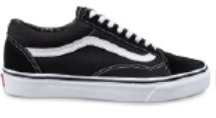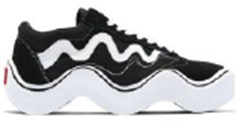In Vans, Inc. v. MSCHF Product Studio, Inc., the first appellate court opinion to apply the U.S. Supreme Court’s decision in Jack Daniel’s Properties v. VIP Products, the U.S. Court of Appeals for the Second Circuit considered whether to recognize heightened First Amendment protection in a sneaker design and bypass the traditional likelihood of confusion analysis for trademark infringement suits.
Background
The Vans case involved a trademark and trade dress infringement lawsuit in which Vans claimed the design of MSCHF’s “Wavy Baby” sneaker infringed upon Vans’ rights in the design of its iconic “Old Skool” sneaker:
 |
 |
| Vans Old Skool sneaker | Wavy Baby sneaker |
Relying on the Second Circuit’s opinion in Rogers v. Grimaldi,[1] MSCHF, a Brooklyn-based art collective, argued that its Wavy Baby sneaker was an expressive work – specifically, a parody of the Vans Old Skool sneaker and a commentary on “the consumerism inherent in sneakerhead culture.” The district court rejected MSCHF’s argument and entered a temporary restraining order and preliminary injunction against further sales of Wavy Baby sneakers. MSCHF appealed the ruling to the Second Circuit.
While MSCHF’s appeal was pending, the Supreme Court issued its decision in Jack Daniel’s v. VIP Products.[2] In that case, VIP Products sold a dog toy called “Bad Spaniels” that was designed to look like a bottle of Jack Daniel’s whiskey but with changes such as the words “Bad Spaniels” instead of “Jack Daniel’s” and “The Old No. 2 on Your Tennessee Carpet” instead of “Old No. 7 Brand Tennessee Sour Mash Whiskey.” VIP Products argued that its dog toy was a parodic expressive work such that the Rogers test should apply as an off-ramp from a traditional likelihood of confusion analysis. The Court held that the Rogers test, and its heightened First Amendment protections, does not apply “when the alleged infringer uses a trademark in the way the Lanham Act cares most about: as a designation of source for the infringer’s own goods.”
The Decision
The issue before the Second Circuit in Vans v. MSCHF was “whether Wavy Baby is subject to trademark law’s traditional likelihood of confusion analysis or whether it is an expressive work entitled to heightened First Amendment scrutiny under Rogers.”
Applying the Supreme Court’s Jack Daniel’s decision to the case before it, the court held that Jack Daniel’s “forecloses MSCHF’s argument that Wavy Baby’s parodic message merits higher First Amendment scrutiny under Rogers.” The court found that “MSCHF used Vans’ marks in much the same way that VIP Products used Jack Daniel’s marks – as source identifiers.” Specifically, the court found that “MSCHF’s design evoked myriad elements of the Old Skool trademarks and trade dress,” namely, the Old Skool black and white color scheme, the side stripe, the perforated sole, the logo on the heel, the logo on the footbed, and the packaging. Significantly, MSCHF included its own branding on the label and heel of the Wavy Baby sneaker, displayed a logo that evoked the Old Skool logo, and did not include a disclaimer disassociating it from Vans or Old Skool sneakers. Because MSCHF used Vans’ trademarks, particularly its red and white logo, to brand its own products, the court found this to be “quintessential trademark use” subject to the Lanham Act.
Thus, notwithstanding the Wavy Baby’s alleged expressive intent, the court held that MSCHF used Vans’ trademarks in a source-identifying manner and that the traditional likelihood of confusion analysis – not the Rogers test – applied to Vans’ trademark and trade dress infringement claims.
The court then applied the Second Circuit’s Polaroid factors to determine likelihood of confusion. The Polaroid factors include: (1) strength of the trademark; (2) similarity between the two marks; (3) proximity of the products and their competitiveness with one another; (4) likelihood the prior owner may ‘bridge the gap’ in the markets for their products; (5) evidence of actual customer confusion; (6) the defendant’s good faith in adopting its imitative mark; (7) quality of the defendant’s product compared with the plaintiff’s product; and (8) sophistication of the buyers.
Having determined that the district court did not err in declining to apply the Rogers test, the court held that the district court correctly found that Vans is likely to prevail on its likelihood of confusion claim. The court held that nearly all the Polaroid factors pointed toward likelihood of confusion. Specifically, the strength of the mark favored Vans because MSCHF admittedly “expressly chose the Old Skool marks and dress because it was ‘the most iconic, prototypical’ skate shoe there is.” Likewise, the similarity of the marks factor weighed in favor of likelihood of confusion because MSCHF’s creative officer admitted the Wavy Baby sneaker design “intentionally evoked an image of Vans’ Old Skool sneaker” and Vans has, in the past, collaborated with artists and other brands. Moreover, finding that the Wavy Baby shoe is a “wearable piece of footwear” as opposed to a piece of art, the court held that the products are competitively proximate, and therefore, the court need not consider whether Vans may bridge the gap by developing a product in MSCHF’s market.
The court also held that Vans’ actual confusion evidence favored a finding of likelihood of confusion, both initial confusion and post-sale confusion, even though consumers who purchased Wavy Baby shoes would receive the accompanying “manifest” explaining the genesis of the shoes. The court also found that these consumers (even though the product sold for over $200) were not sophisticated because they were not “professional buyers.”
Takeaways
Given the Supreme Court’s decision in Jack Daniel’s, the Second Circuit’s ruling in Vans v. MSCHF comes as no surprise and underscores the challenge of applying the Rogers test to what Justice Kagan at oral argument in the Jack Daniel’s case referred to as an “ordinary commercial product.” If the purported parodist’s product competes against the brand owner’s product (as the Second Circuit found to be the case), the bar is set at an even higher level. As the Second Circuit pointed out (quoting from the district court’s decision), courts “have not hesitated to prevent a manufacturer from using an alleged parody of a competitor’s mark to sell a competing product.” Yet artistic expression takes many forms, including on commercial products that convey a parodic or social commentary. The contours of Jack Daniel’s may continue to be defined as artists ply their craft in the world of commercialism.
[1] Under the test established in Rogers, the Lanham Act should not apply to “artistic works” as long as the defendant’s use of the mark (1) is artistically relevant to the work, and (2) is not “explicitly misleading as to the source or content of the work.”
[2] See June 2023 GT Alert, “Rogers Test in Unsettled Paw-sition After SCOTUS’s Latest Trademark Decision.”


